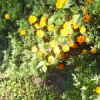Whats the difference between interior and exterior emulsion?
By sketchy from Devon, UK
Add your voice! Click below to answer. ThriftyFun is powered by your wisdom!

Emulsion Paints
Modern Emulsions are water-based, with vinyl or acrylic resins added to make them more hard-wearing than traditional emulsions. This results in varying degrees of sheen in the finish; as the shine increases, the paint tends to be more hard wearing. The ranges usually offer matt, eggshell, silk, satin and full gloss.
Although normally thought of as for internal walls and ceilings, there are water based types of emulsion specially produced for woodwork. These are easy to apply but do not give the same hard-wearing qualities as oil-based paints.
Interior Walls and Ceilings
Emulsion is the most popular paint for walls and ceilings due to the fact that it is water based and has less smell, dries comparatively quickly and is easy to apply.
There are three main types of emulsion used for walls and ceilings, each giving a different finish:
Vinyl matt emulsion gives a matt, non-shiny finish that is good for not showing small imperfections on the wall or ceiling. (The shinier finishes reflect back more light and highlight any imperfections). Generally speaking, however, it does not wear as well as the glossier emulsions.
Vinyl satin emulsion gives a subtle soft-sheen finish and is a more durable surface than vinyl matt. It is suitable for areas that might need to be occasionally lightly washed or sponged.
Vinyl silk emulsion gives a high sheen finish and is the most durable of all the emulsion paints. It is good for rooms that are subject to a lot of moisture i.e. condensation. Some manufactures make specific Kitchen & Bathroom paint which is ideal for areas of high humidity.
There are other types of paint available for specific jobs. These include:
Primer - These may be oil or water based and are used to seal unpainted surfaces to prevent covering coats of paint soaking in. The appropriate type of primer should be used for the surface being painted - wood, metal, plaster or tiles. There are some 'all purpose primers' available which are designed for two or more of these surfaces.
Undercoat - Usually oil-based, undercoat is applied on top of the primer. The undercoat should be of the correct colour to provide the right colour base for the finishing coats.
Anti-condensation - For use in humid conditions such as in kitchens and bathrooms, this paint ii specially formulated to prevent the surface becoming cold to the touch and therefore less conducive to condensation. It is not a cure for condensation, only a way of reducing its effect on painted surfaces. They often include a fungicide. Normal emulsion paints may be satisfactory in these conditions providing that the level of condensation is not too high.
Radiator paint - For use on central heating pipes and radiators, it will stand up to the high temperatures without discolouring as other paints are prone to do.
Fire-retardant - These special paints contain an additive to provide a fire-resistant quality, they do not resist fire completely, but has a greater flame resistance than ordinary paint and will reduce their spread.
Bituminous - Although often not considered as a paint, bitumen is used where a water proof coating is required. Bitumen does not dry in the normal sense used with paint, it can crack if stressed when frozen and will run (or at least become sticky to the touch) in hot weather. Thick and usually black, bitumen is for areas where high water resistance is needed and appearance is not important - such as on the inside of cast iron guttering and metal cold water tank.

Modern Emulsions are water-based, with vinyl or acrylic resins added to make them more hard-wearing than traditional emulsions. This results in varying degrees of sheen in the finish; as the shine increases, the paint tends to be more hard wearing. The ranges usually offer matt, eggshell, silk, satin and full gloss.
Although normally thought of as for internal walls and ceilings, there are water based types of emulsion specially produced for woodwork. These are easy to apply but do not give the same hard-wearing qualities as oil-based paints.
Interior Walls and Ceilings
Emulsion is the most popular paint for walls and ceilings due to the fact that it is water based and has less smell, dries comparatively quickly and is easy to apply.
There are three main types of emulsion used for walls and ceilings, each giving a different finish:
Vinyl matt emulsion gives a matt, non-shiny finish that is good for not showing small imperfections on the wall or ceiling. (The shinier finishes reflect back more light and highlight any imperfections). Generally speaking, however, it does not wear as well as the glossier emulsions.
Vinyl satin emulsion gives a subtle soft-sheen finish and is a more durable surface than vinyl matt. It is suitable for areas that might need to be occasionally lightly washed or sponged.
Vinyl silk emulsion gives a high sheen finish and is the most durable of all the emulsion paints. It is good for rooms that are subject to a lot of moisture i.e. condensation. Some manufactures make specific Kitchen & Bathroom paint which is ideal for areas of high humidity. Good luck.
Add your voice! Click below to answer. ThriftyFun is powered by your wisdom!